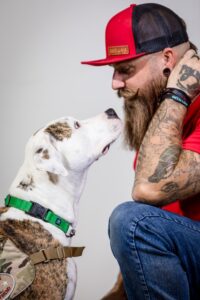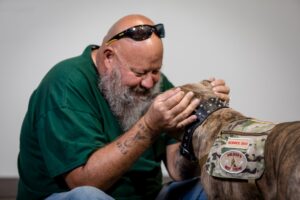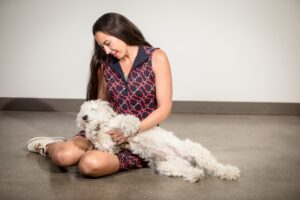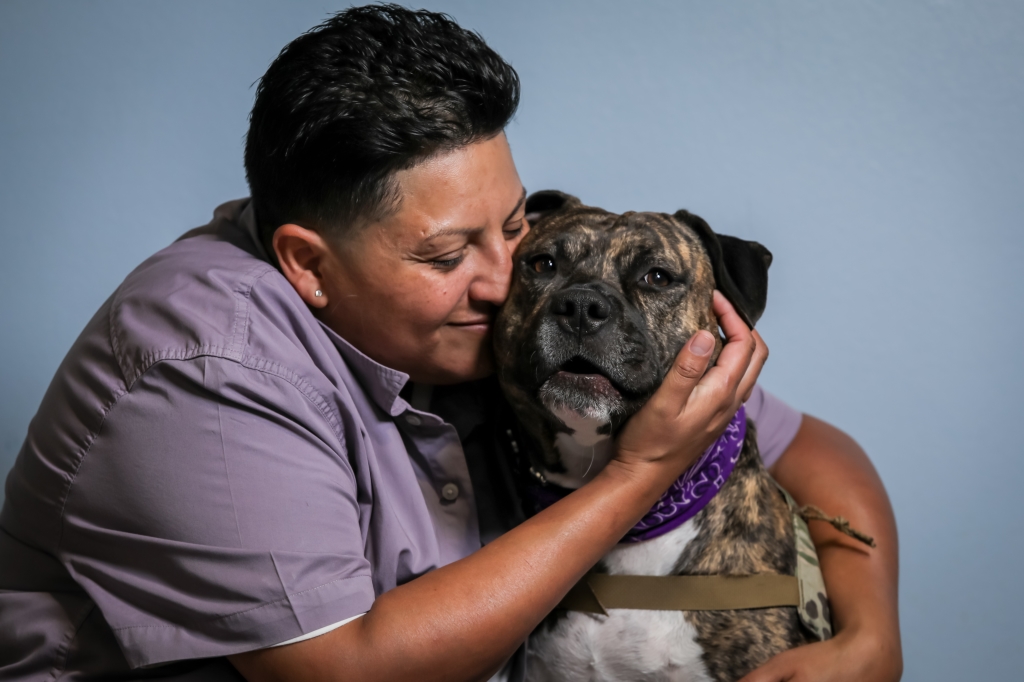Writer Joseph J. Airdo // Photography Courtesy of Soldier’s Best Friend
For the past 13 years, Soldier’s Best Friend has been making a difference in Arizona, two lives at a time.
The Peoria-based nonprofit organization provides U.S. military veterans living with combat-related post-traumatic stress disorder or traumatic brain injury with service or therapeutic companion dogs, most of which are rescued from local shelters, fostering trusting, mutually beneficial, lifesaving human-animal relationships.
Among the more than 566 lives touched since its 2011 founding are those of Rebecca and Toffee, a veteran-dog team whose testimony is captured on Soldier’s Best Friend’s website. In 2022, Rebecca recounted her 12-year struggle with PTSD following her deployment to Iraq, where she witnessed some terrible things while serving in the U.S. Air Force.
“PTSD left me fighting with depression and anxiety, especially in public spaces,” explained Rebecca, noting that she particularly disliked driving in rush hour traffic. “I found Toffee after waiting for months for an adoption and couldn’t be happier with his temperament and love.
“The bond formed between dog and veteran was powerful and immediate. Whenever I start to have an anxiety attack, Toffee is right there, putting his face up to mine, saying, ‘It’s OK. I’m here for you.’ The training we have received from Soldier’s Best Friend has been life-changing, and I feel that I can be in public spaces now with Toffee by my side.”



Hounds and Heroes
Soldier’s Best Friend was founded by John Burnham, a veterinarian who sought to do something that engaged his military interests, honored his late father and allowed him to use his personal and professional talents to a greater degree in service to the community.
“Dr. Burnham recognized the profound connection between veterans and their dogs, particularly in relation to mental health issues,” says Mik Milem, who joined Soldier’s Best Friend as its executive director two years ago. “In 2011, service dogs had been around for some time, but their use for PTSD and traumatic brain injury among veterans was relatively new and not widely recognized by the VA as a legitimate tool for mental health support.
Inspired by his personal observations, Burnham conducted research that confirmed the positive impact of dogs in the healing process for PTSD. With the support of his wife and business partner, Jan, he embarked on a journey to provide support to veterans through the human-animal bond, placing and training service dogs for our veterans at no cost to them while simultaneously reducing pet overpopulation.
Since its founding, Soldier’s Best Friend has rescued more than 260 homeless dogs in Arizona.
“Our organization has partnerships with animal rescues across Arizona,” Milem explains. “We employ a full-time adoption specialist who visits these rescues and assesses dogs for suitability in our program. The dogs undergo a behavioral evaluation and temperament testing to ensure their fitness as service animals.”
Milem says the ideal dog is calm and confident, one that can tolerate a lot of interaction without reacting. Nonreactivity to other dogs, distractions and loud noises is also important in temperament testing because it indicates that a dog is not easily disturbed.
“Once they pass all of these assessments, we remove them from the rescue and place them with one of our foster families for four weeks,” Milem continues. “This allows us to observe any potential behavioral issues, as we may not have complete information about the dogs’ backgrounds. If any problems arise, they will appear at the foster’s home rather than the veteran’s.”
Soldier’s Best Friend also conducts a medical evaluation, ensuring that all vaccinations are up to date and that the dogs’ hips are sound, as they will be working animals. After passing all evaluations, a formal meet and greet is arranged.
“It is often said that the dog chooses the veteran,” Milem says. “It is frequently observed that some dogs do not respond to specific veterans, while they may respond to the next one.”
Milem adds that while there are no breed restrictions for a dog to be trained as a Soldier’s Best Friend service dog, the nonprofit organization prefers not to place pit bull mixes and Dobermans with veterans since some landlords have restrictions against such breeds. However, the organization will happily train any dog that a veteran already owns and brings into the program.



Bark of Duty
“The first step in working with a veteran and a dog is bonding,” the executive director says. “This involves hand-feeding the dog and keeping it by the veteran’s side at all times, initially with a leash if necessary. Bonding is essential for allowing the dog to attune to the veteran and naturally pick up on certain symptoms that may occur.
“Remarkably, by graduation, a dog can typically sense an anxiety attack before the veteran even realizes it is coming. This is because of specific twitches or the release of cortisol in the body during high anxiety, which dogs can pick up on. While we do not stay at the veteran’s home at night, the bonding with the dog allows it to sense the veteran’s nightmares, as the dog sleeps in the same bedroom. Typically, the dog wakes the veteran up before the nightmare becomes intense, which is a result of the bonding that we facilitate.”
The dogs are also trained to provide pressure therapy for their veterans during anxiety attacks.
“When the dog snuggles up and presses into the veteran’s core, it helps shift the veteran’s focus away from whatever is causing their anxiety and back to the dog,” Milem says. “This provides a sense of purpose and responsibility, as the veteran needs to take care of their dog. During training, veterans are instructed to keep their eyes on their dogs and take care of them. In return, the dogs keep their eyes on and take care of their veterans.”
In other words, more familiar to veterans, the dogs “watch their six.”
“The dogs are trained to create space for their veterans in public, alleviating concerns about people approaching them from behind and surprising them,” Milem adds. “The dog keeps an eye out for potential threats and alerts their veteran by tapping them with their nose or paw or bumping them with their head.”
With training locations in Phoenix, Tucson, Prescott, Sierra Vista, Flagstaff, Yuma and Show Low, Soldier’s Best Friend has graduated 383 veteran-dog teams from its program since its founding.
“On a recent Saturday, I graduated a veteran with a tiny service dog that weighed only three or four pounds,” Milem says. “At the same graduation, I had a German shepherd mix that weighed a hefty 75 pounds. It truly goes to show that any dog can be trained as a service dog, depending on the needs of the veteran.”
Veterans are welcome to continue training for the life of their dog through Soldier’s Best Friend’s ongoing graduate training classes to keep honing their skills. They also have the opportunity to enroll in classes that are focused on specific tasks.
“We also offer support groups and mentorship programs,” Milem adds. “In these mentorships, graduates help those currently in the program, not necessarily with their mental health issues, but by talking them through the challenges of the program. Training a dog is not easy. Every veteran at some point feels like they cannot do it. It is helpful to have a mentor who can say, ‘I felt the same way, and I did it, so you can, too.’”



Guardians of Honor
Although he does not have any immediate family members who are veterans, except for a few uncles who served in the Korean War, Milem has always felt strongly about veterans’ causes. In fact, while serving as the dean of students at Grand Canyon University earlier in his career, he developed close relationships with many student veterans — including three with whom he has maintained contact.
He adds that while working as the interim executive director and chief operating officer of the Arizona Burn Foundation, he immersed himself in PTSD therapy to understand the traumatic events burn survivors endure and the profound impact it has on their mental health.
“PTSD became familiar to me,” Milem says. “I grasped its nature as an invisible, hidden disability that manifests differently for each individual. I also learned about the array of triggers that may not be apparent to others but are nevertheless real and debilitating.
“However, I was unaware of the formidable challenges that our veterans face in accessing the mental health resources they desperately need. The Phoenix VA, often portrayed negatively due to its history, is not solely responsible for this situation. It is overwhelmed by the sheer number of veterans seeking mental health assistance — 30,000 for all mental health issues, including 12,000 specifically for PTSD. The VA is doing its best, but the gap in resources is undeniable.”
He has also become acutely aware of the alarming rate of veteran suicides in the U.S. — an average of 22 each day.
“Tragically, one of our employees, a graduate of our program, died by suicide last May,” Milem says. “He had become like a son to me and my family. I have witnessed firsthand the lack of resources that perpetuates the suffering within the veteran community, and it is deeply troubling to me.”
Therefore, the need for organizations like Soldier’s Best Friend to fill the gap is tremendous — as is the need for support from the community. Milem says that while the organization always welcomes donations, its most urgent request at the moment is for foster volunteers to care for dogs until they can be placed with veterans.
“We currently have 14 veterans waiting for their dogs,” Milem explains. “The delay is because we do not have enough fosters. If we had 14 fosters, all the dogs could be placed with veterans within a month. However, we only have five or six foster volunteers who come and go, as it is challenging to foster multiple dogs, become attached to them and then see them placed with someone else. Therefore, we always need more fosters who are willing to care for dogs knowing that they will eventually go to veterans who need them.”
Soldier’s Best Friend also welcomes volunteers to help with office work and fundraisers — such as its annual sporting clays event each spring and its upcoming Flag Day luncheon, during which attendees will have an opportunity to hear firsthand how the nonprofit organization is changing lives, two at a time.
“Working as executive director of Soldier’s Best Friend has been the most rewarding experience of my career,” says Milem, who has always loved dogs and has rescued several of his own. “I get to witness firsthand the transformative impact of our work on the lives of veterans and I am surrounded by wonderful dogs every day. What more could I possibly ask for?”
Soldier’s Best Friend Luncheon
Friday, June 14 // 11 a.m. // Chicken N Pickle // 9330 W. Hanna Lane, Glendale // $100 // 623-218-6486 // soldiersbestfriend.org







Comments by Admin